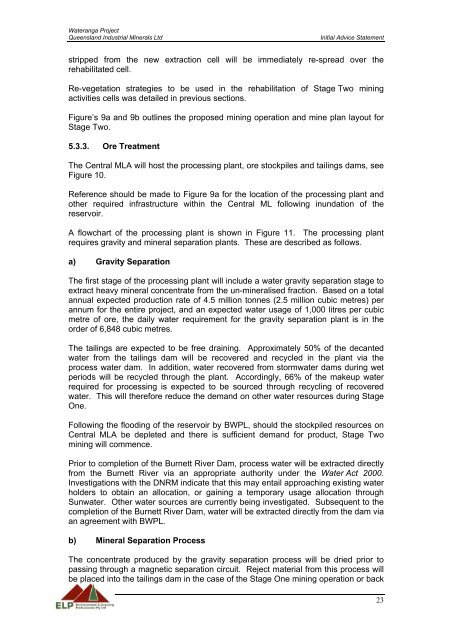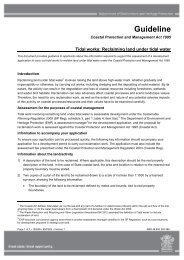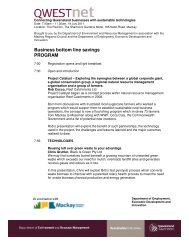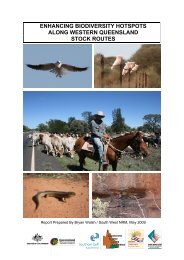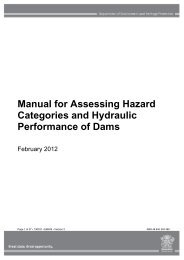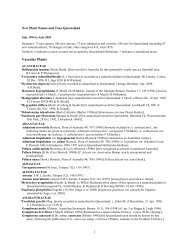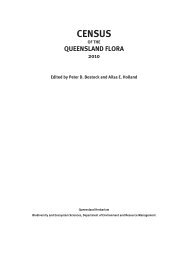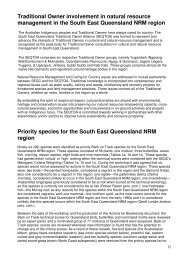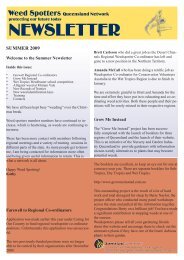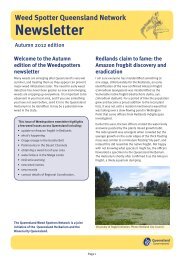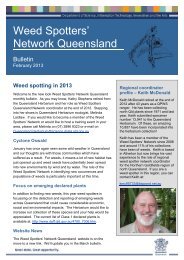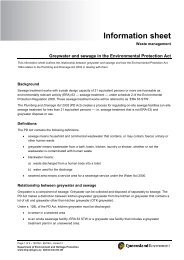WATERANGA PROJECT - Department of Environment and Heritage ...
WATERANGA PROJECT - Department of Environment and Heritage ...
WATERANGA PROJECT - Department of Environment and Heritage ...
Create successful ePaper yourself
Turn your PDF publications into a flip-book with our unique Google optimized e-Paper software.
Wateranga Project<br />
Queensl<strong>and</strong> Industrial Minerals Ltd Initial Advice Statement<br />
stripped from the new extraction cell will be immediately re-spread over the<br />
rehabilitated cell.<br />
Re-vegetation strategies to be used in the rehabilitation <strong>of</strong> Stage Two mining<br />
activities cells was detailed in previous sections.<br />
Figure’s 9a <strong>and</strong> 9b outlines the proposed mining operation <strong>and</strong> mine plan layout for<br />
Stage Two.<br />
5.3.3. Ore Treatment<br />
The Central MLA will host the processing plant, ore stockpiles <strong>and</strong> tailings dams, see<br />
Figure 10.<br />
Reference should be made to Figure 9a for the location <strong>of</strong> the processing plant <strong>and</strong><br />
other required infrastructure within the Central ML following inundation <strong>of</strong> the<br />
reservoir.<br />
A flowchart <strong>of</strong> the processing plant is shown in Figure 11. The processing plant<br />
requires gravity <strong>and</strong> mineral separation plants. These are described as follows.<br />
a) Gravity Separation<br />
The first stage <strong>of</strong> the processing plant will include a water gravity separation stage to<br />
extract heavy mineral concentrate from the un-mineralised fraction. Based on a total<br />
annual expected production rate <strong>of</strong> 4.5 million tonnes (2.5 million cubic metres) per<br />
annum for the entire project, <strong>and</strong> an expected water usage <strong>of</strong> 1,000 litres per cubic<br />
metre <strong>of</strong> ore, the daily water requirement for the gravity separation plant is in the<br />
order <strong>of</strong> 6,848 cubic metres.<br />
The tailings are expected to be free draining. Approximately 50% <strong>of</strong> the decanted<br />
water from the tailings dam will be recovered <strong>and</strong> recycled in the plant via the<br />
process water dam. In addition, water recovered from stormwater dams during wet<br />
periods will be recycled through the plant. Accordingly, 66% <strong>of</strong> the makeup water<br />
required for processing is expected to be sourced through recycling <strong>of</strong> recovered<br />
water. This will therefore reduce the dem<strong>and</strong> on other water resources during Stage<br />
One.<br />
Following the flooding <strong>of</strong> the reservoir by BWPL, should the stockpiled resources on<br />
Central MLA be depleted <strong>and</strong> there is sufficient dem<strong>and</strong> for product, Stage Two<br />
mining will commence.<br />
Prior to completion <strong>of</strong> the Burnett River Dam, process water will be extracted directly<br />
from the Burnett River via an appropriate authority under the Water Act 2000.<br />
Investigations with the DNRM indicate that this may entail approaching existing water<br />
holders to obtain an allocation, or gaining a temporary usage allocation through<br />
Sunwater. Other water sources are currently being investigated. Subsequent to the<br />
completion <strong>of</strong> the Burnett River Dam, water will be extracted directly from the dam via<br />
an agreement with BWPL.<br />
b) Mineral Separation Process<br />
The concentrate produced by the gravity separation process will be dried prior to<br />
passing through a magnetic separation circuit. Reject material from this process will<br />
be placed into the tailings dam in the case <strong>of</strong> the Stage One mining operation or back<br />
23


